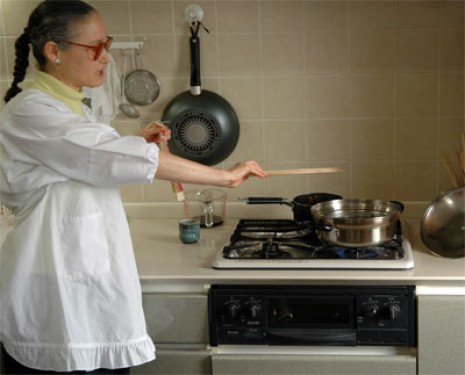A FORMER GOURMET COLLEAGUE WRITES FROM JAPAN
Ever curious about the world at large, Gourmet published its first big piece about Japanese food, “Song of Sashimi,” in 1958. Beginning in the 1970s, the person most responsible for the depth, passion, and accuracy of the magazine’s Japan coverage was contributing editor Elizabeth Andoh, the leading English-language authority on the subject.
Elizabeth is a brilliant teacher—her “Taste of Culture” culinary arts programs in Tokyo and Osaka are legendary—and just watching her exacting yet unfussy movements in the kitchen gives you insight into another world and another, very mindful, philosophy.
Yesterday, ten days after the devastating events in Japan, she wrote, “Nature’s onslaught continues with hundreds of strong aftershocks, many accompanied by yet more tsunami. Other big quakes in nearby Nagano (March 12), Shizuoka (March 15), Yamagata and Chiba (March 18) Prefectures continue to unnerve everyone …. To compound the horror, ensuing damage to a large nuclear power plant in Fukushima Prefecture is proving difficult to contain and repair, making the whole world tense.”
Because the rolling blackouts in Tokyo continue to wreak their own havoc, Elizabeth made her way to Osaka, where she and her husband have a second home. “With the exception of certain nationwide shortages (flashlights, batteries, instant noodles, and bottled water chief among them), supermarket shelves in Osaka are full,” she explained. “Energy reduction is voluntary, though earnest—many households are contributing savings on their utility bills to relief efforts. Seismic activity is gentler here, too, though still worrisome.”
She was clear about the fact that she is not a front-line reporter, offering instead “a few words that capture the spirit and mood in Japan, as it struggles in the aftermath of catastrophic natural disaster.”
Dictionary of a Determined Nation
by Elizabeth Andoh
I begin with SHIMBOU-ZUYOI, which describes people with great stores of patience—calmly applying their fortitude, especially in exasperating circumstances.
辛抱強い
shimbou-zuyoi
Next on my list is GAMAN-ZUYOI, a similar concept. Forgoing, or at least postponing, personal needs so that others can benefit … that is what defines someone who is gaman-zuyoi.
我慢強い
gaman-zuyoi
Sharing limited food, water, and blankets in freezing emergency shelters requires shimbou (patience) and gaman (endurance) … as does postponing unessential repairs and rescheduling your day to accommodate erratic rolling energy blackouts. Shimbou-zuyoi and gaman-zuyoi people are much admired in Japanese society.
Conversely, those thinking only of their own needs are deemed to be WAGAMAMA (which has nothing to do with the noodle-bar chain); they are frowned upon.
応援・支援・協力
ouen … shien … kyouryoku
Support takes many forms. OUEN is similar to cheerleading (hang in there, we’re rooting for you!) while SHIEN is more often financial backing (donations, underwriting projects). The word for cooperation, KYOURYOKU, is written with multiple “strength” (chikara) calligraphy. Pooling strengths and resources results in powerful cooperation.
In closing, Elizabeth wrote, “The Japanese are individually and collectively practicing shimbou and gaman, and doing their best in the ouen, shien, and kyouryoku departments, too,” and appended a list of disaster-relief organizations**. Seeing her words and conjuring her—small, indomitable, and laden with her emergency kit-knapsack (the contents, detailed in an earlier email, include flashlight, extra batteries, water, essential medications, money, identification papers, gloves, face mask, first aid supplies, and an extra sweater with hood)—made me want to show respect in a way I knew she would understand.
I pulled her latest book, Kansha: Celebrating Japan’s Vegan and Vegetarian Traditions, down from the shelf and made a quick trip to Katagiri, the oldest Japanese grocery store in the United States. Happily, it is right in my neighborhood.
Then I cooked something restorative: A thick, slithery udon noodle soup rich with mushrooms and topped with kale, grated fresh ginger, and slivers of daikon, carrot, and thin fried tofu. When I blanched the little bundle of greens, I plucked it out of the boiling water with the long chopsticks Elizabeth gave me years ago. “They are in-cred-ibly useful!” she said crisply, when I opened the box. I’ll bet a pair of those were packed in her emergency-kit knapsack, too.
* For an in-depth look at how raw fish took America by storm, read Anne Mendelson’s “A Fish Story,” which appeared in the October 2002 issue.
Posted: March 23rd, 2011 under cooking, culinary history, favorite books, food, Gourmet magazine, people + places.


